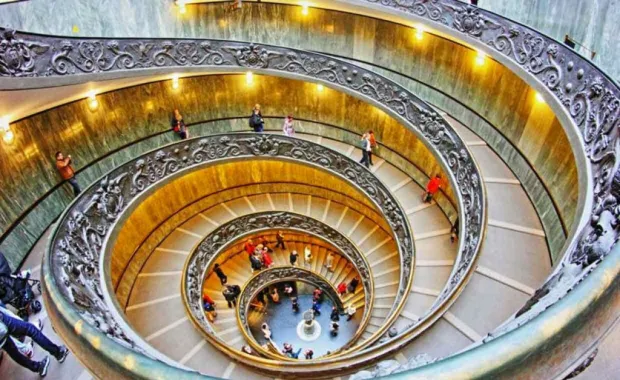

VATICAN MUSEUMS AND SISTINE CHAPEL
A visit that takes you to the highest peaks of art of all time, where Beauty and Faith meet in a unique union.
The prestigious collections 'inaugurated' in 1506 by Julius II, who was the first to exhibit the most beautiful sculptures from his collection in the Courtyard of the Statues (now the Octagon), are now five centuries old. Organized in definitive displays between the end of the 18th century and the first half of the 19th century, the papal collections constitute a complex of exceptional importance both for the richness and quality of the works they bring together (from the 5th to the 20th century) and for the sumptuousness of the spaces in which they are housed, in the Apostolic Palace and in the buildings and wings around the courtyards of the Pigna, the Library and the Belvedere.
Since 2000, the museums have been accessed through an entrance where all the services are concentrated. Spread over two floors (plus a third for exhibitions and a fourth for internal museum services), it is furnished with modern and ancient works including a polychrome mosaic from the 1st century BC which perhaps depicts the Tiber port of Rome. From here, the visitor is guided to the exhibition areas along a large spiral ramp that crosses the Corazze courtyard, covered by a steel and glass structure. The visit is planned according to four itineraries (marked with distinct colors), different in length and levels of in-depth study of the boundless collections.
Sistine Chapel
The chapel, seat of the conclaves for the election of the popes, takes its name from Sixtus IV della Rovere, who between 1477 and 1480 had the ancient Cappella Magna rebuilt by Giovannino de' Dolci and in 1481-83 turned to some of the most famous Umbrian and Tuscan masters of the time for the execution of the frescoes on the side walls (over 40 m long) and in front of the altar. In 1506 Julius II resumed the decorative project, entrusting it to Michelangelo , who between 1508 and 1512 frescoed the lunettes and the vault; twenty-three years later the master returned to the Sistine Chapel to paint the back wall with the Last Judgement ( 1535-1541).
We recommend a guided tour with Civitatis click here
For information and reservations at Simon Hotel Pomezia use the form below
 loading form _
loading form _
Since 2000, the museums have been accessed through an entrance where all the services are concentrated. Spread over two floors (plus a third for exhibitions and a fourth for internal museum services), it is furnished with modern and ancient works including a polychrome mosaic from the 1st century BC which perhaps depicts the Tiber port of Rome. From here, the visitor is guided to the exhibition areas along a large spiral ramp that crosses the Corazze courtyard, covered by a steel and glass structure. The visit is planned according to four itineraries (marked with distinct colors), different in length and levels of in-depth study of the boundless collections.
Sistine Chapel
The chapel, seat of the conclaves for the election of the popes, takes its name from Sixtus IV della Rovere, who between 1477 and 1480 had the ancient Cappella Magna rebuilt by Giovannino de' Dolci and in 1481-83 turned to some of the most famous Umbrian and Tuscan masters of the time for the execution of the frescoes on the side walls (over 40 m long) and in front of the altar. In 1506 Julius II resumed the decorative project, entrusting it to Michelangelo , who between 1508 and 1512 frescoed the lunettes and the vault; twenty-three years later the master returned to the Sistine Chapel to paint the back wall with the Last Judgement ( 1535-1541).
We recommend a guided tour with Civitatis click here
For information and reservations at Simon Hotel Pomezia use the form below
